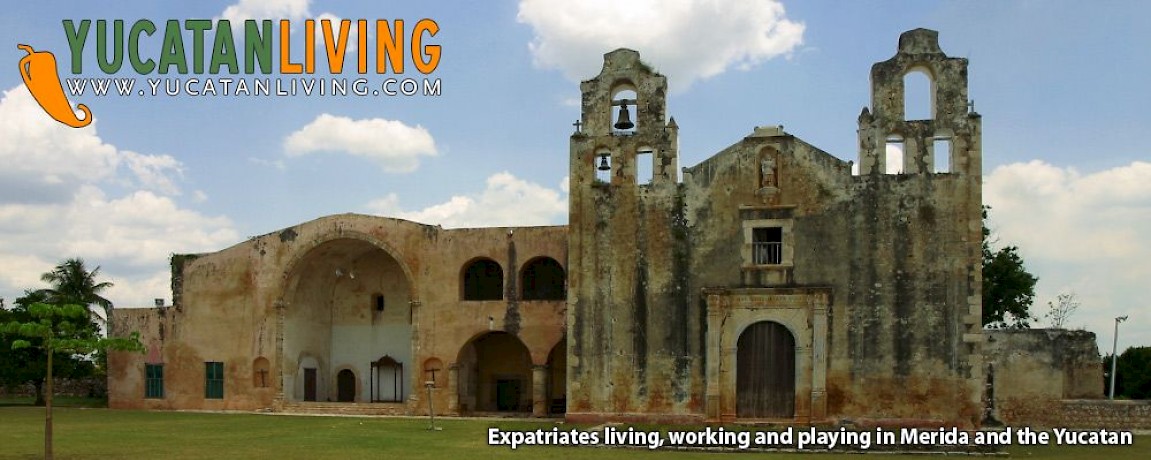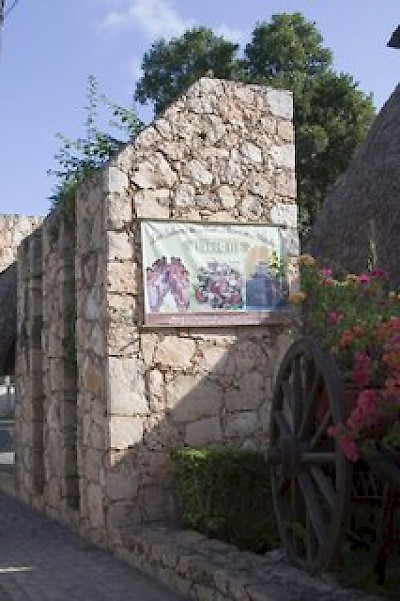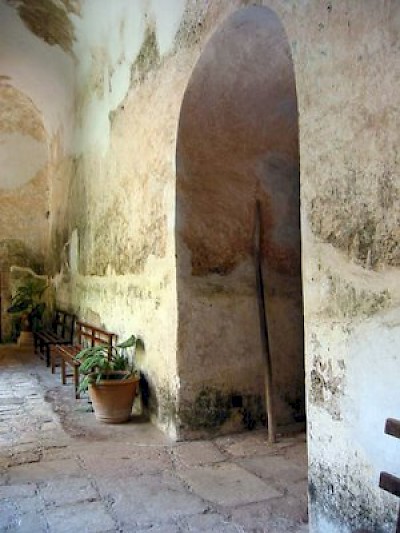The Ghosts of Mani
We've been to Mani twice, and its always been sunny, bright and warm. In other words, a typical Yucatan day. The pueblo centers around a large renovated iglesia (church) that is itself surrounded by a large open space. It takes a little over an hour to drive there from Merida, and you can continue on to Uxmal if you want to make a day of it.
Mani is a sleepy little Mayan pueblo. As in many places in the Yucatan, there are ghosts here, but you'd never know it.
The last time we went to Mani, we had breakfast at the second most famous thing about Mani, the restaurant called Tutul-Xiu. This restaurant is known for its delicious poc-chuc (a baked pork dish) and other authentic Yucatecan cuisine items. On weekends, we hear, the place is packed. When we were there, we were the only diners... but it is a large restaurant obviously used to bigger crowds. For the record, we had a delicious plate of huevos con chaya (scrambled eggs with the spinach-like vegetable that grows here called chaya) and huevos mexicanos (scrambled eggs with tomatoes and onions). The tortillas were handmade and hot from the griddle... there are no better tortillas in the world than hot-off-the-griddle Yucatecan tortillas. And the habanero sauce was hot and made us cry. The jarras de tamarindo and fresh orange juice helped a lot with that. In short, a great breakfast.
But enough about that.
There's also a very lovely and large church in Mani (see the first photo). The altar and the interior have recently been restored, and they are quite lovely and worth seeing. Attached to the main church is a monastery building where I'm sure monks and friars once lived while they were doing what Mani is *most* famous for. It is barely inhabited now... the huge rooms and patios with stone floors, the wide stairs, the thick arched walkways are all very still and a little eerie on a quiet Yucatecan afternoon.
What is really famous about Mani is something that happened here in 1562. The Franciscan missionaries living in this church discovered that the Mayans whom they thought were converted to Christianity had reverted to their traditional spiritual practices. Horrified, they began torturing various Mayans to find out what they were doing and where. Frey Diego de Landa, a senior monk, showed up and took over. He ordered all their books, statues and other accoutrements smashed and burned. Later in life he was quoted as saying, "We found a large number of books in these characters and, as they contained nothing in which were not to be seen as superstition and lies of the devil, we burned them all, which they (the Maya) regretted to an amazing degree, and which caused them much affliction". He burned countless precious books about the Mayans, their history and their spiritual beliefs and practices.
There were so many of these books (not just in Mani) that I've read some people have compared it to burning the library in Alexandria... in other words, erasing the major record of an entire culture. Today, so few of these codices or books have survived that they are well known by their names, which are derived from the locations where they are kept (such as the Dresden and Paris Codices). If you ever have a chance to see any of these in person, you will be amazed by the detail, color and beauty of the art that is Mayan writing.
Years later, it is said, Fray Diego de Landa bitterly regretted what he had done, thinking that he would have been able to convert the Mayans more easily if he had understood their religion and culture. Fool! He apparently spent the rest of his life recording whatever he could learn from the Mayans to try to make up for what had been lost. The result is a book that anyone interested in the Yucatan will find fascinating: "The Account of the Things of Yucatan" by Fray Diego de Landa. In the restaurant where we ate breakfast, we found a painting of the event. And on another wall is a complete accounting in Spanish of the event, including a recount of *exactly* how many statues, how many books and how many other things were confiscated and burned by the good Christians. The people of Mani have not forgotten, and the ghosts of their ancestors are very much present. When you visit, walk softly and with respect.
They may be watching.
For more information about Fray Diego de Landa and his terrible acts, try these pages:
http://www.latinamericanstudies.org/landa.htm
http://users.skynet.be/fa039055/lifedeat.htm
http://www.ancientamerica.org/library/media/384chapter13.htm












Comments
Tomas 7 years ago
There must be another church in Mani that you described because the one in the main square is anything but "lovely". Landa should not only be sorry for his genocidal work but also for his lack of architectural awareness. When I was in Mani I mourned the loss of the Mayan Architecture. The stone from the Mayan site was used for this boxey church and some other boxey buildings in Mani. I was told the church is no longer open for visitors as it is crumbling. Maybe just a rumor.
Something you did not mention which,to me, is the high point of the village is the large number of talented embroiderers. I watched a woman making incredibly intricate lace on an ancient treadle sewing machine while her husband made a beautiful hammock by hand. We visited a number of talliers, one more outstanding than the other. The handmade work is my favorite over the machine made even if a little more pricey.
Reply
Jen 9 years ago
Thanks for a great read. I have always wanted to visit Mani, and am researching my next return to Yucatan - so this is helpful :)
Now - to the readers who justify the destruction of Mayan history, I'd like to recommend that you read some history about what was going on in Europe while Landa was supposedly saving mankind from evil.
The Witch Hunts lasted from roughly 1200-1750. The Spanish Inquisition started in 1480, and wasn't officially abolished until 1834.
Landa was not trying to stop anything evil. His purpose was to assimilate and convert, even if it meant physical torture, humiliation, and severe oppression. Had the Mayans not participated in human sacrifice, Landa still would have taken severe measures to assimilate and convert, as is the case globally.
The Church has so much blood on its hands, I'm not sure how anyone can call the Mayans "evil." I personally believe human sacrifices were more about controlling mass populations through fear, which is not uncommon of any state society. Self-mutilation is not uncommon in other religions, and should not be viewed as more evil when Mayans partake in such practices, than when Christians do.
It is an absolute tragedy that Landa burned so many manuscripts. I am not a religious person, but I would think it a great tragedy had someone burned the Dead Sea Scrolls as an attempt to stop the gruesome, torturous killings of some 60,000 believed to have been killed for practicing witchcraft. Those people were tortured in horrific ways before being killed violently. All in the name of God.
I really hope those who are studying the Maya can keep some perspective on hand. I don't post this to slam the Church, as I do not blame modern Christians for Christian history; however, I have never perceived human sacrifice as more evil than burning someone at the stake for hearing voices, or for being an herbalist. In fact - at least the sacrifices that were made were quick and to the point, rather than long drawn out affairs that lasted weeks before a gruesome end.
I sure look forward to visiting Mani, as it will be the perfect follow-up to my travels in Yucatan. I think it goes without saying that Izamal is another fantastic place to visit, if interested in the history of Diega de Landa and the Maya. I have read his Account of Things in Yucatan, and though it frustrates me to no end that he destroyed so much, I have also read that several Mayan Scholars consider his book the Maya Rosetta Stone, because without it, the workings of the Mayan Calendar would remain a mystery. Ironic? Sure- but at least we can thank him for that.
(As per another post - I also read that he was forced to record everything he could remember about the manuscripts he destroyed, and that it wasn't done out of free will. I will have to do more research into this.)
Reply
Steve 17 years ago
Hello Working Gringos,
I live not far from La Ermita Church and was very interested in what you said about De Landa's written account being found there. I'm currently writing a paper about De Landa and would love to find a source for this information so I can include it in the paper. Do you know of a book or article that mentions the details of the discovery?
Reply
Land, Luxury, Leisure…Explore Pacific Mexico :: New Real Estate Law: January 1, 2009 17 years ago
[...] Moving On Up! Look at Mani Go! Mani is a small municipality to the south of Merida. Almost all of the fewer than 4,000 residents are Mayan and Mayan is the language that is spoken there. The residents of Mani applied to an international program that helps poor communities design a successful future for themselves – and Mexico determined that, of all the places in the nation, our Mani would be the beneficiary of this pilot program. The people of Mani wanted to become successful without having to depend on tourism to do it. Members of the IDP (International Design Partnership) came to visit and saw the beautiful embroidery produced in Mani. They suggested putting that same design in a variety of linens and paper products, such as stationary and cards. Right now, eight top-class designers from South-Africa, Great Britain, Peru, Chile, Mexico, the USA, Germany and Australia are meeting in Mexico City to develop a merchandising concept for traditional products from the Maya cultural stronghold of Mani in order to improve the local living conditions. You can read the full story of this project and Yucatan Living’s story of the history of Mani. [...]
Reply
Yucatan Living - News: 17 years ago
[...] Moving On Up! Look at Mani Go! Mani is a small municipality to the south of Merida. Almost all of the fewer than 4,000 residents are Mayan and Mayan is the language that is spoken there. The residents of Mani applied to an international program that helps poor communities design a successful future for themselves – and Mexico determined that, of all the places in the nation, our Mani would be the beneficiary of this pilot program. The people of Mani wanted to become successful without having to depend on tourism to do it. Members of the IDP (International Design Partnership) came to visit and saw the beautiful embroidery produced in Mani. They suggested putting that same design in a variety of linens and paper products, such as stationary and cards. Right now, eight top-class designers from South-Africa, Great Britain, Peru, Chile, Mexico, the USA, Germany and Australia are meeting in Mexico City to develop a merchandising concept for traditional products from the Maya cultural stronghold of Mani in order to improve the local living conditions. You can read the full story of this project and Yucatan Living’s story of the history of Mani. [...]
Reply
tusreba 18 years ago
I think that it is strange that people are still pointing fingers back so many centuries. The real point is that we should learn from the past and do our best not to repeat it. Most cultures have used their culture and religion and caused a great deal of hurt to others. Only about 80 to 100 years ago, the Christain missionaries to Alaska did about the same thing as Landa to the native peoples of Alaska. One of those missionaries was my grandfather. He had a great love and respect for the native Alaskans but could not stop the powers that be from being stupid in their actions to the Alaskans. I only hope we have learned what not to do.
Reply
Sarah Bogdanski 18 years ago
Very interesting - I am headed to Mani next week to have a birthday lunch in a Mayan home. I have never been there, but after reading this I am really looking forward to going!
Reply
Working Gringos 19 years ago
Grant,
We've read Landa's account and many others, and from what we can learn, literal human sacrifices by the Mayan were rather rare (and influenced by Toltec culture, not Mayan). When Landa uses the word "sacrifice", he is more often refering to self-mutilation or animals.
In any event, the Mayan have every right to regret the loss of their cultural heritage. All ancient cultures engaged in some sort of sacrificial ritual (see the Bible), but few have endured the loss of their sacred texts over it.
Also, as a point of historical fact, Landa wrote his account in Yucatan. The copy he sent to Spain was, uh... "misplaced", but the original was discovered several centuries later in the convent at La Hermita in Merida.
Meanwhile, at the same time that Landa was "saving" sacrificial victims from the supposedly backward Mayans, the supposedly civilized Spaniards were sacrificing their own people to appease their God in that little ditty you mentioned called the Inquisition.
And the beat goes on...
Reply
Grant 19 years ago
I've never heard the he recanted anything. He wrote his account of the Yucatan in Spain, as a defense to charges that he had illegally conducted an inquisition. Landa was acquitted, and returned as Bishop of the Yucatan.
Certainly the loss of the Mayan works was a tragedy, and it would have been nice for us if Landa could have arranged to have the books shipped out to Spain, but in my mind, at least, that takes distant second to the importance of putting a final end to the Mayans deeply ingrained human sacrifice rituals.
I suppose it is natural for the modern Maya to paint themselves as victims without painting the many people they themselves victimized. Certainly a mural showing the book burning mural is more conducive to poc chuc sales at Principe Tutul Xiu than one showing Mayans eating roast arms and legs with chiles and tomatos, in a building made of skulls.
Btw, I have copies of both Landa's book and Bernal Diaz's Conquest of Mexico in Merida, which I'd be very happy to lend. Fascinating reads.
Reply
Working Gringos 19 years ago
Actually, didn't Landa recant after burning everything, wish he hadn't done it, and then spent the rest of his life studying and trying to preserve the very culture he helped destroy? That's the way we've heard it.
And judging by the plaque on the wall in the restaurant in Mani, that's the way the local Mayans see it nowadays too.
But as you said, none of us were there! And its always the winners that write the history. Especially when the winners are literate and the losers are not.
Reply
Grant 19 years ago
I agree with Eric Thompson, the noted Mayan archaeologist, who wrote that we should stop the handwringing over Landa's book burning. The most important thing was to stop the institutionalized murder at the center of Mayan religion. Landa was there and thus in a far better position to know what steps were necessary than anyone living 500 years later. Stamping out that evil was worth just about any cost, as any of the reprieved victims would undoubtedly have agreed. Landa clearly was not a xenophobe, as his detailed and sympathetic account of Mayan culture demonstrates.
Reply
(0 to 11 comments)Next »